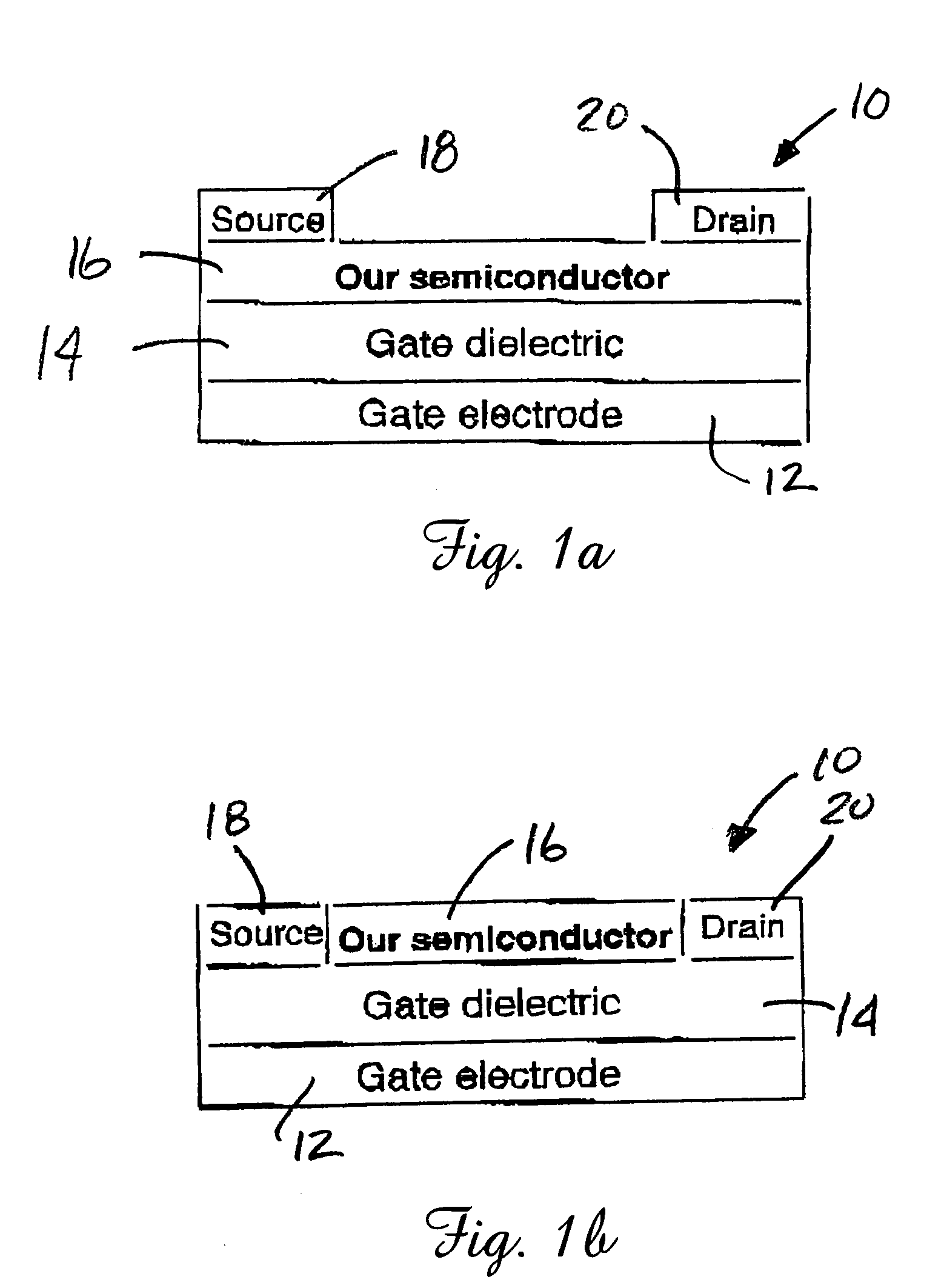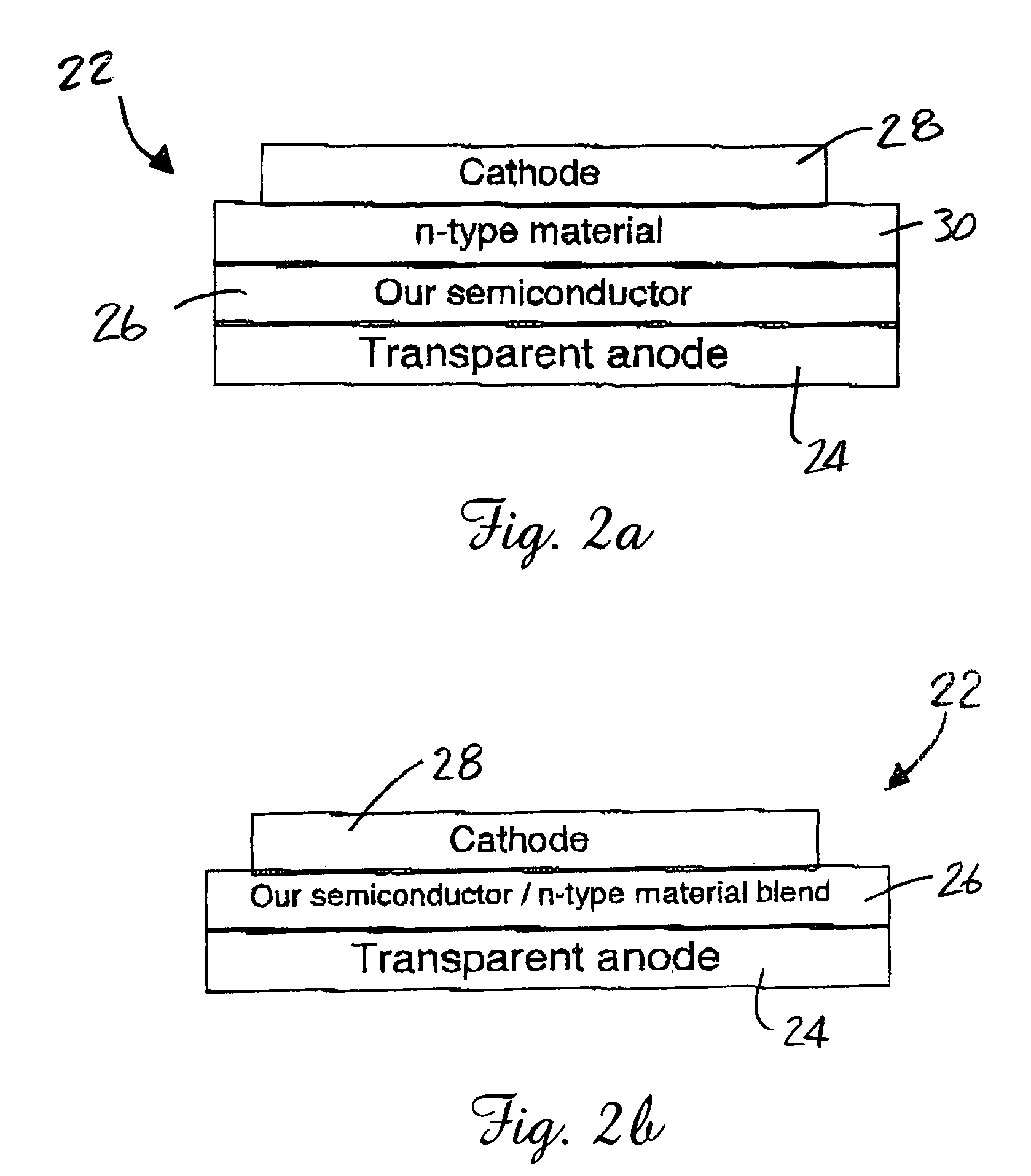Silylethynylated heteroacenes and electronic devices made therewith
a technology applied in the field of sillylethynylated heteroacenes and electronic devices made therewith, can solve the problems that current solution deposition techniques have not demonstrated material structure, thickness and property control comparable to vacuum deposition techniques
- Summary
- Abstract
- Description
- Claims
- Application Information
AI Technical Summary
Benefits of technology
Problems solved by technology
Method used
Image
Examples
example 1
[0035]5,11-Bis(triethylsilylethynyl)anthra [2,3-b:6,7-b′] dithiophene and 5,11-Bis(triethylsilylethynyl)anthra [2,3-b: 7,6-b′] dithiophene. To an oven-dried 250-mL round-bottom flask equipped with a stir bar and cooled under N2 was added hexanes (20 mL) and 0.38 mL of triethylsilyl acetylene (2.0 mmol), followed by the dropwise addition of 0.73 mL of n-BuLi (1.8 mmol, 2.46 M solution in hexanes). This mixture was stirred for 1 h, then hexanes (80 mL) and anthradithiophenequinone (prepared by method described in De la Cruz, P. et al. J. Org. Chem. 1992, 57, 6192.) (0.16 g, 0.34 mmol) were added. The mixture was heated at 60° C. overnight, then quenched with 0.5 mL of water. SnCl2.2H2O (0.50 g, 2.2 mmol) in 10% aq. HCl (1 mL) was added and the mixture was stirred for 2 h at 60° C. The solution was dried over MgSO4, then loaded onto a thick pad of silica. The silica was rinsed with hexanes (500 mL), then the product was eluted using hexanes:DCM (5:1). Removal of solvent yielded 0.18 g ...
example 2
[0036]Tetra[2,3-b:8,9-b′] dithiophene-5,13-dione and Tetra[2,3-b:9,8-b′]dithiophene-5,13-dione. A 1:2 mixture of 2,3-thiophenedicarboxaldehyde (0.85 g, 6.07 mmol) and benzo[1,2-b]thiophene-4,5-dicarboxaldehyde (1.66 g, 8.70 mmol) was dissolved in THF (200 mL) in a 500-mL round-bottom flask with a stir bar, then 1,4-cyclohexanedione (0.83 g, 7.40 mmol) was added and the solution was stirred until uniform. After the addition of 15% KOH (2 mL), precipitate began to form immediately, and vigorous stirring was continued overnight. The solution was filtered to yield 3.87 g of a light brown powder made up of insoluble quinones which were used directly in the next step: MS (70 eV, EI) m / z 370 (100%, M+).
5,13-Bis(tris(trimethylsilyl)silylethynyl)tetra [2,3-b:8,9-b′] dithiophene and 5,13-Bis(tris(trimethylsilyl)silylethynyl)tetra[2,3-b:9,8-b′]dithiophene. To an oven-dried 500-mL round-bottom flask cooled under N2 and equipped with a stir bar was added hexanes (150 mL) and tris((trimethylsilyl...
example 3
[0037]Penta[2,3-b:9,10-b′]dithiophene-6,14-dione and Penta[2,3-b:10,9-b′]dithiophene-6,14-dione. In a 500-mL round-bottom flask equipped with a stir bar, benzo[1,2-b]thiophene-4,5-dicarboxaldehyde (2.35 g, 12.4 mmol) was dissolved in THF (200 mL). 1,4-Cyclohexanedione (0.70 g, 6.2 mmol) was added and stirred until the solution was uniform, then 15% KOH (2 mL) was added. Vigorous stirring was continued overnight, then the solution was filtered and rinsed with ether (20 mL) and DCM (20 mL). The brown solid was heated to reflux in DMF (400 mL) for 2 hr, then cooled and filtered to yield 1.6 g (3.8 mmol) of the desired quinone as a light brown insoluble powder. MS (70 eV, EI) m / z 420 (42%, M+).
[0038]6,14-Bis(tri(t-butyl)silylethynyl)-penta [2,3-b:9,10-b′] dithiophene and 6,14-Bis(tri(t-butyl)silylethynyl)-penta [2,3-b:10,9-b′]dithiophene (6b). To an oven-dried 250-mL round-bottom flask equipped with a stir bar and cooled under N2 was added anhydrous THF (40 mL) and tri(t-butyl)silyl ace...
PUM
| Property | Measurement | Unit |
|---|---|---|
| carrier energy bandwidth | aaaaa | aaaaa |
| temperature | aaaaa | aaaaa |
| volume | aaaaa | aaaaa |
Abstract
Description
Claims
Application Information
 Login to View More
Login to View More - R&D
- Intellectual Property
- Life Sciences
- Materials
- Tech Scout
- Unparalleled Data Quality
- Higher Quality Content
- 60% Fewer Hallucinations
Browse by: Latest US Patents, China's latest patents, Technical Efficacy Thesaurus, Application Domain, Technology Topic, Popular Technical Reports.
© 2025 PatSnap. All rights reserved.Legal|Privacy policy|Modern Slavery Act Transparency Statement|Sitemap|About US| Contact US: help@patsnap.com



